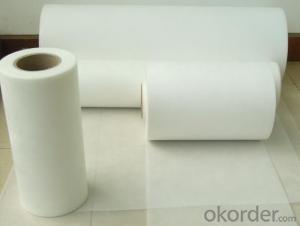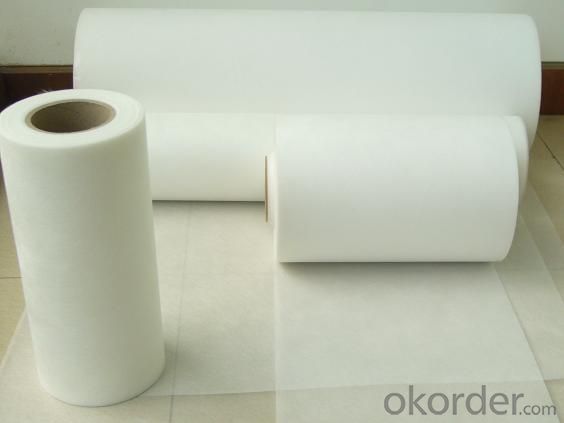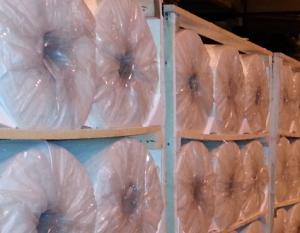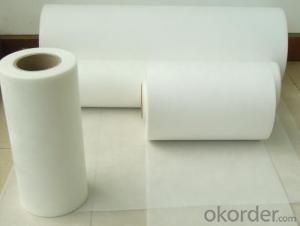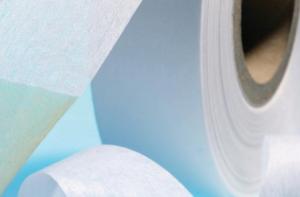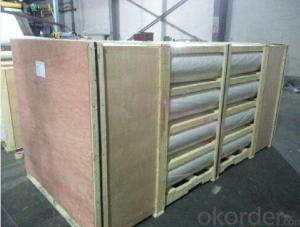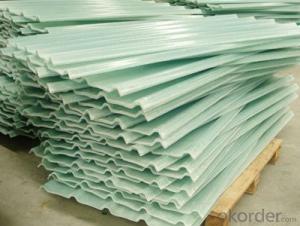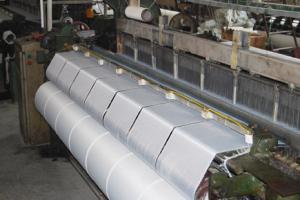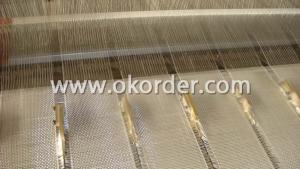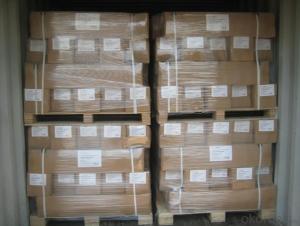Fiberglass Fabrics Surfacing Tissue Mat
- Loading Port:
- China Main Port
- Payment Terms:
- TT or LC
- Min Order Qty:
- 72000 m²
- Supply Capability:
- 1440000M2 Per Month m²/month
OKorder Service Pledge
OKorder Financial Service
You Might Also Like
1.Brief Introduction1.Brief Introduction
Surfacing Tissue mainly used in the surface layers of FRP products. It features even Fiber distribution, soft feel, level and smooth fiber surface, less glue content, quick resin soak and good pattern fitness. It can improve the product surface property on corrosion resistance, compressive strength, seepage resistance, and longer service life. It is also suitable for spraying; pattern pressing and other FRP pattern technology.
2.Characteristics
Fast breakdown in styrene
Fiber dispersed evenly
Low binder content
Superior acid corrosion resistance
3.Specifications
Item | Unit | Specification |
Area Weight | g/m2 | 30+/-3 |
Binder Content | % | 6-9 |
Tensile Strength MD | N/125px | ≥35 |
Soaking time | S | ≤10 |
Moisture content | % | ≤0.5 |
Width length
| mm
| 1270
|
Roll Diameter
| m | 300
|
Paper Core Internal Dia | mm | 76 |
Special specification can be produce according to customer requirements.
4.FAQ
a.Pacage
Each Surface Tissue is wound onto a paper tube which has an inside diameter of 76mm and the mat roll has a diameter of 330mm. The mat roll is wrapped up with plastic film,and then packed in a cardboard box or wrapped up with kraft paper. The rolls can be vertically or horizontally placed. For transportation, the rolls can be loaded into a cantainer directly or on pallets.
b.Product storage:
Unless otherwise specified, Chopped Strand Mat should be stored in a dry, cool and rain-proof area. It is recommended that the room temperature and humidity should be always maintained at 15℃~35℃ and 50%~75% respectively.
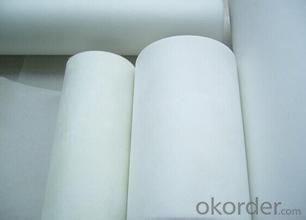
- Q: Is fiberglass fabric suitable for use in medical dressings?
- Fiberglass fabric is indeed appropriate for use in medical dressings. It possesses numerous characteristics that render it perfect for this purpose. Firstly, its high durability and strength offer exceptional support and protection to wounds or injuries. Additionally, it resists tears and punctures, ensuring the dressing remains intact even when in motion. Furthermore, fiberglass fabric is lightweight and breathable, allowing the passage of air and moisture, which aids in healing and prevents infections. Moreover, it is non-absorbent, meaning it does not retain moisture, thereby preventing the dressing from becoming damp or uncomfortable. Furthermore, fiberglass fabric is hypoallergenic, reducing the likelihood of allergic reactions in patients with sensitive skin. Overall, these qualities make fiberglass fabric an appropriate option for medical dressings as it provides the necessary protection and support while ensuring comfort and promoting healing.
- Q: The function of roof glass fiber non-woven fabric isolating layer
- Glass fiber isolation layer non-woven fabrics: waterproof, breathable, steam film, reflective insulation,
- Q: Can fiberglass fabric be used for reinforcement in water purification tanks?
- Yes, fiberglass fabric can be used for reinforcement in water purification tanks. Fiberglass fabric is known for its excellent strength-to-weight ratio and durability, making it a suitable material for reinforcing tanks that are constantly exposed to water. It provides reinforcement to the tank structure, preventing it from deforming or collapsing under the weight of the water or from external forces. Additionally, fiberglass fabric is resistant to corrosion and chemicals, ensuring that it remains intact and does not contaminate the water during the purification process.
- Q: What does "PCB" mean?
- We can't transmit electrical signals just as insulation plates, so we need to cover the surface with copper. So we call the PCB board a copper clad substrate. In the factory, the common copper substrate in this code is FR-4, each card manufacturers which in general there is no difference, so we can think of everyone at the same starting line, of course, if it is best to use high frequency board, copper clad PTFE glass cloth laminate high cost. The process of copper is very simple, generally can be made by rolling and electrolytic solution, the so-called rolling is Gao Chundu (>99.98%) of the copper rolling method on the PCB substrate, because the adhesive has excellent epoxy resin and copper foil, copper foil adhesive strength and high working temperature, can be no bubble dip in the molten tin is 260 DEG C in. This process is like rolling dumpling wrappers, but the dumpling wrappers are thin and thin. The thinnest is less than 1mil (industrial unit: mil, 1/1000 inches, equivalent to 0.0254mm)! If the dumpling wrappers are so thin, the pot must leak! The so-called electrolytic copper in junior high school chemistry has learned, CuSo4 electrolyte can continuously manufacture a layer of "copper foil", this is more easy to control the thickness, the longer the copper foil the more thick! Usually the factory has strict requirements on the thickness of copper foil, usually between 0.3mil and 3mil, and has a dedicated copper foil thickness tester to test its quality. Like old radios and amateur PCB, copper is especially heavy, and the quality of the factory is far worse than the computer board.
- Q: How does fiberglass fabric perform in thermal expansion?
- Fiberglass fabric exhibits satisfactory performance in terms of thermal expansion. Its composition of interwoven glass fibers results in a minimal coefficient of thermal expansion (CTE), causing it to expand and contract at a negligible rate when exposed to temperature changes. This attribute renders it highly suitable for applications that require dimensional stability, including composite materials, insulation, and thermal protection systems. The low CTE of fiberglass fabric effectively prevents warping, distortion, and cracking that may occur in materials with higher rates of thermal expansion. Furthermore, the fabric's capacity to endure high temperatures without significant expansion further enhances its efficacy in thermal expansion applications. All in all, the fabric's low CTE contributes to its versatility and dependability in diverse industries, establishing it as the preferred choice for applications sensitive to thermal expansion.
- Q: How does fiberglass fabric perform in flexural strength?
- The excellent flexural strength properties of fiberglass fabric are well-known. This term refers to a material's ability to withstand bending or flexing without breaking or deforming. Fiberglass fabric, created by weaving fine glass fibers together, demonstrates high flexural strength due to the inherent properties of glass. The glass fibers offer exceptional rigidity and resistance to bending forces, resulting in a highly durable fabric that can endure significant flexing loads. The structure of fiberglass fabric allows for the even distribution of applied loads across its surface. This minimizes stress concentration points and prevents localized failure, enabling the material to maintain its shape and integrity even when subjected to substantial bending or flexing conditions. Furthermore, the manufacturing process of fiberglass fabric allows for tailoring the orientation and arrangement of the glass fibers, thus enhancing its flexural strength. By strategically aligning the fibers, the fabric can exhibit even greater resistance to bending forces in specific directions. Additionally, fiberglass fabric is often combined with resins or coatings to create composite materials, further enhancing its flexural strength. The resin matrix serves as a binder, offering additional support and stability to the glass fibers and improving the overall performance of the fabric. Overall, fiberglass fabric is highly regarded for its outstanding flexural strength, making it the preferred choice for applications that demand high durability and resistance to bending or flexing forces.
- Q: How does fiberglass fabric perform in water repellency?
- Fiberglass fabric is not inherently water repellent. However, it can be treated with various coatings or finishes to enhance its water repellency.
- Q: Can fiberglass fabric be used for insulation tapes?
- Yes, fiberglass fabric can be used for insulation tapes. Fiberglass fabric is known for its excellent thermal insulation properties, making it an ideal material for insulation tapes. It can effectively prevent heat transfer and provide insulation for various applications, such as electrical, HVAC, and industrial insulation. In addition, fiberglass fabric is also resistant to fire, chemicals, and moisture, making it a durable and reliable option for insulation tapes.
- Q: How does fiberglass fabric handle moisture and humidity?
- Fiberglass fabric is known for its excellent resistance to moisture and humidity. Unlike other materials, it does not absorb water or become weakened or damaged by exposure to moisture. This makes it highly durable and suitable for applications in high-humidity environments or areas prone to moisture.
- Q: Is fiberglass fabric resistant to aging or deterioration?
- Yes, fiberglass fabric is highly resistant to aging and deterioration. Its durable nature allows it to maintain its strength and structural integrity over time, making it a reliable option for various applications.
Send your message to us
Fiberglass Fabrics Surfacing Tissue Mat
- Loading Port:
- China Main Port
- Payment Terms:
- TT or LC
- Min Order Qty:
- 72000 m²
- Supply Capability:
- 1440000M2 Per Month m²/month
OKorder Service Pledge
OKorder Financial Service
Similar products
Hot products
Hot Searches
Related keywords
